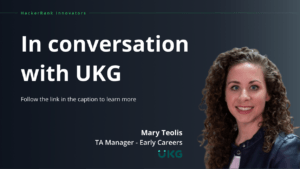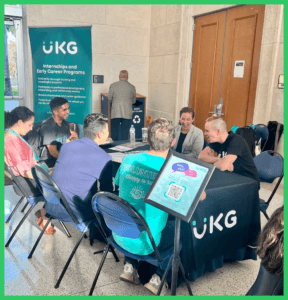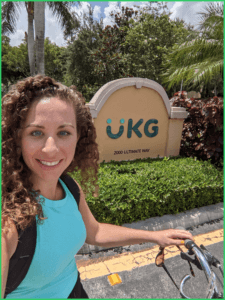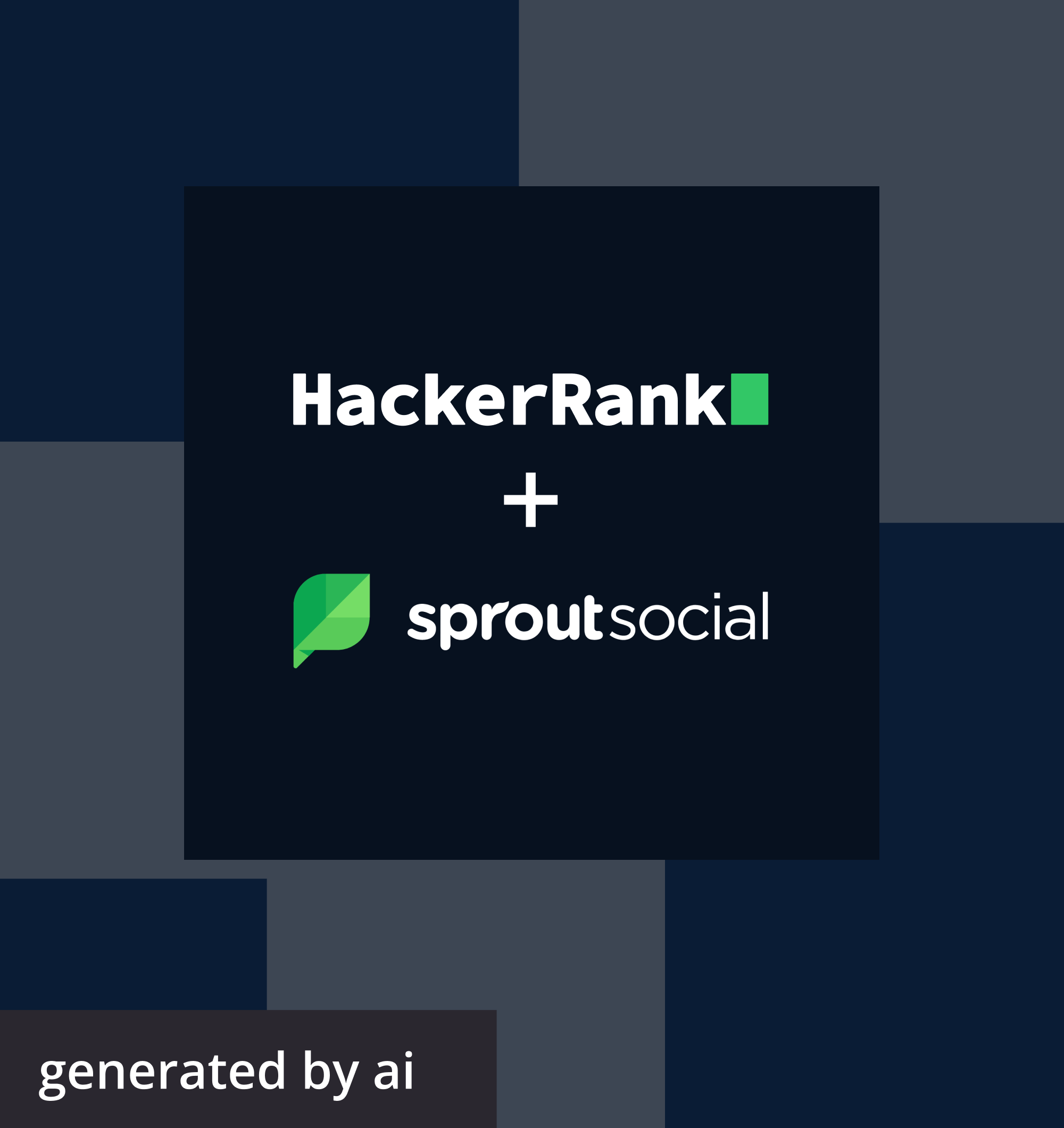
In an era marked by economic fluctuations and evolving industry landscapes, early career recruitment requires careful planning and people optimization. Talent acquisition teams are pressed to deliver exceptional results amidst hiring pauses, budget constraints, and heightened expectations.
Moreover, candidate experience holds significance in early career recruitment efforts. Engaging with candidates effectively, providing timely feedback, and offering valuable resources are crucial components in building a positive impression of the company. In an environment where potential hires have an abundance of options, creating a memorable candidate journey is a key differentiator.
So, to understand how to set candidates up for success early in their career, we spoke with Mary Teolis, Talent Acquisition Manager, Early Careers, at UKG.
Mary Teolis is a seasoned talent acquisition professional who has played a pivotal role in supporting UKG’s growth in the last five years. Presently, Mary holds the responsibility of overseeing UKG’s Americas internship program, which encompassess sales, finance, tech, and other departments. In addition to her core responsibilities, Mary is actively engaged in navigating strategic challenges such as mergers, acquisitions, and resource limitations.

- How does UKG leverage technology to streamline and automate the initial stages of candidate screening?
At UKG, the process of candidate screening is a critical part of our recruitment strategy, considering the sheer volume of applicants we receive, often numbering in the tens of thousands for a couple of hundred positions. Our primary goal is to quickly identify and engage with qualified candidates, ensuring a high-touch and timely candidate experience. We recognize that today’s candidates, especially Gen Z, value prompt responses from prospective employers.
To achieve this, we leverage technology to streamline and automate the initial stages of candidate screening. One key aspect of our strategy involves establishing strong partnerships with local college campuses and student-led organizations that align with our company culture and values. Over the past few years, we’ve invested significantly in these partnerships, allocating resources, and engaging individuals who can provide valuable insights, teach courses, or conduct knowledge-sharing sessions with students.
Now, to address your question directly, we use our application system to create special links for each of these partnerships. These links are tied to specific tags and source codes within our application system, allowing us to identify candidates who have come through these partnerships. When candidates apply through these special links, they are immediately highlighted in our system, effectively moving them to the top of the candidate stack. This approach ensures that we promptly identify and prioritize candidates who have engaged with our partner organizations.
For example, we send hard-coded links to students through the platforms we have, enabling us to track candidates originating from specific campaigns. This data-driven approach helps us focus our attention on the right candidates efficiently.
Additionally, we employ a similar strategy on external platforms to identify and engage with candidates from diverse talent sources. These efforts are all part of our commitment to providing a high-touch and responsive candidate experience, which we believe sets us apart in a competitive talent landscape.
- Do you also use any personalized methods to enhance this experience?
We organize webinars where we provide a detailed walkthrough of our interviewing process, especially for technical candidates. We highlight common pitfalls and offer tips for success. One of the most frequent inquiries we receive is how candidates can best prepare for interviews or applications. In such cases, we consistently guide them to the valuable resources available on HackerRank. As someone without a software engineering background myself, I’m impressed by how extensively our team relies on HackerRank’s expertise and knowledge base. It’s reassuring to know that, particularly for early career candidates, there’s a rich repository of resources on HackerRank. While it’s not feasible to personally walk through every technical assessment with candidates who didn’t pass, we can confidently communicate that our assessment questions serve as a foundational measure of what’s required for success in our initial interview stage. If a candidate finds it challenging, we encourage them to revisit the resources on the platform.
- What best practices would you recommend for crafting job descriptions that attract the right candidates and promote diversity and inclusion?
When it comes to crafting job descriptions that resonate with candidates and promote diversity and inclusion, there are a few key practices that have proven effective at UKG. First and foremost, we understand the importance of brevity, especially considering that candidates often read job descriptions on their mobile devices. This drives us to be concise in our descriptions, while still effectively conveying our culture, mentorship opportunities, and the support system we provide for success.

In our job descriptions, we make it a point to highlight our comprehensive onboarding process. This includes targeted training, access to resources, and mentorship, all designed to ensure a smooth transition into the corporate world. We believe this sends a strong message to early career candidates that at UKG, we’re invested in their growth from day one.
Additionally, we emphasize factors that matter most to early career professionals. They want to work on real projects, collaborate within teams, and see the direct impact of their contributions on the organization’s success. We make sure to communicate this clearly in our job descriptions, letting candidates know they won’t be working on theoretical exercises, but rather on projects that drive real-world results.
Furthermore, we take a proactive approach to ensure inclusivity by using gender-neutral language in our job descriptions. We utilize tools that analyze the language to ensure it doesn’t unintentionally exclude or target specific demographics. This helps us attract a diverse pool of candidates who can contribute their skills and perspectives to our organization.
Overall, these practices have not only helped us attract top talent but have also fostered an environment of diversity and inclusion within our organization. We believe that by implementing these strategies, we are not only setting candidates up for success but also cultivating a work culture that celebrates differences and values the contributions of every individual.
- Can you give an example of how thoughtful, people-centric practices have led to recruitment wins for UKG?
I’d like to highlight an innovative approach that our recruiting strategy in India has taken, particularly in the realm of women in technology. While I don’t directly oversee this strategy, I find it truly commendable. They’ve implemented a unique initiative aimed at welcoming women into the tech space. What sets this approach apart is the recognition that the most senior person in the household often plays a significant role in decision-making. To address this, they extend invitations to family members, including parents and in some cases, even grandparents, to come and experience our culture firsthand. This gives them an opportunity to engage with our leadership team and gain a clear understanding of how their loved ones will thrive within our organization.
This approach has proven instrumental in breaking down barriers and dispelling reservations some may have about entering the workforce. It’s a testament to how thoughtful cultural considerations can revolutionize recruitment, particularly in areas where early career opportunities are prevalent. This approach has significantly contributed to the successful integration of women technologists into our team. So, beyond utilizing gender decoders, we also place great emphasis on understanding the unique cultural dynamics in each region where we offer early career opportunities, ensuring that our recruitment efforts are tailored to meet the specific needs and preferences of candidates.
- How do you incorporate skill-based assessments and work simulations to better evaluate candidates’ capabilities?
In evaluating our candidates, particularly for entry-level internship positions, we employ HackerRank’s skill-based assessments to gauge their foundational understanding of object-oriented programming and algorithms. This assessment serves as a crucial benchmark for us to ensure that candidates have the fundamental skills required. We guide our interns towards resources on the platform to help them feel adequately prepared for this assessment. Additionally, we provide them with insights on the optimal stage in their curriculum to undertake this assessment, based on the experiences of previous cohorts.
Given that I don’t have a background as a software engineer, having a robust assessment component is invaluable for a talent acquisition organization like ours. It allows us to objectively affirm that a candidate possesses the necessary baseline skill set. This, coupled with their performance in behavioral interviews and their potential cultural fit within the organization, forms a comprehensive evaluation.
While we don’t include capstone projects in our assessment process, we do require candidates to undergo a technical interview, specifically a live coding interview utilizing the HackerRank platform. The objective here is not to assess perfect syntax, but rather to observe their ability to think critically, articulate their thought process, pose insightful questions, and collaboratively work towards a solution with our interviewer. The platform effectively replicates a real-world office environment, providing candidates with a glimpse of what they would encounter on the job.
It has become an integral part of our standard evaluation process, ensuring that candidates are not only technically proficient but also possess the problem-solving and collaborative skills essential for success in our organization.
- How does HackerRank’s skills analytics factor in when it comes to optimizing and iterating hiring strategies?
One crucial aspect we delve into is assessing the effectiveness of our team’s initial talent evaluation from resumes. We aim to improve our pass rates and set benchmarks using HackerRank analytics as a scorecard metric. Essentially, we evaluate how proficient we are in analyzing resumes to make informed decisions about whether candidates should progress to the first interview stage. If we observe a lower pass rate, it prompts us to reevaluate our assessment criteria and potentially adjust our strategies. This year, we’ve taken a deep dive into these analytics and have set new goals based on the insights gleaned from HackerRank reports.
In terms of specific metrics, we don’t heavily focus on time-to-fill metrics within my team, especially for early career positions, where the fill rate can extend up to eight months from posting to hire. Instead, we emphasize candidate quality as a significant metric. It’s worth noting that we refrain from sharing a candidate’s score on the initial assessment with the hiring team. We believe in providing a holistic representation of a candidate’s capabilities, rather than relying solely on assessment scores as a measure of quality.
Our unique approach involves conducting behavioral interviews before the technical assessment—a practice that differs from standard procedures. Instead of sending only those with perfect or near-perfect scores to our team of recruiters, we engage with a broader pool of candidates. This shift in strategy has been a game-changer for us. By interacting with candidates face-to-face, we can better gauge their readiness for the role. For those who may not be fully prepared, we offer guidance, resources, and timelines to help them improve their skills. This approach has not only resulted in a more diverse candidate pool but has also allowed us to nurture talent effectively.
In essence, our strategy prioritizes candidate support and engagement over efficiency metrics. We believe in providing candidates with clear expectations, resources, and opportunities to develop their skills, fostering a more inclusive and diverse talent pool for our organization.
- Has UKG made any changes in the recruitment team’s structure given the need of skills analytics, recruitment analytics, and changing skills expectations?
In terms of skills analytics and recruitment analytics, we acknowledge the ever-evolving nature of skills in today’s dynamic landscape. Cataloging and precisely defining skills, even within our own organization, can be a complex endeavor, especially in the recruitment process.

Regarding changes in our team structure specifically geared towards skills analytics, it’s a nuanced situation. While we recognize the importance of analytics in recruitment, especially in terms of data-driven decision-making, our approach differs slightly. We understand that in order to remain competitive in the next three to five years, addressing the knowledge and skills gap is imperative. We’re already witnessing this need, as specific technologies, such as Kotlin, are gaining prominence.
For our early careers team, which we affectionately refer to as talent advisors, we adopt a two-fold approach. On one hand, we appreciate the organization’s need for specific skill sets, and we work closely to understand the basic and preferred qualifications sought after. However, we also take on the responsibility of providing training and resources to bridge any potential gaps.
Ultimately, our focus, especially for early career, centers on bringing in individuals with a foundational skill set, coupled with a passion for learning and a propensity for quick adaptation. While we may not have an extensive analytics dashboard at the intern level, we believe in the value of nurturing talent with a strong foundation and the potential for growth.
- What recommendations do you have to improve the candidate experience to ensure a positive impression of our company, regardless of the hiring outcome?
Ensuring a positive candidate experience, regardless of the hiring outcome, is paramount for us at UKG. One crucial aspect that I would highlight is our commitment to providing detailed and constructive feedback to candidates who have dedicated their time and effort throughout the interview process. We understand that this process can be rigorous, involving application, assessments, and multiple interviews.
When a candidate progresses to the final interview stage, we make it a point to have a thorough conversation with them. During this discussion, we take the time to break down their technical and coding interviews, offering specific and actionable feedback. Additionally, we extend an invitation for them to reapply after six months.
This practice reflects our belief in investing in individuals’ development, even if they may not have advanced to the final stages of the hiring process. We want candidates to leave with the understanding that their journey with us doesn’t end here. Especially for early career candidates navigating this process for the first time, it’s important for them to know that there are opportunities for growth and development.
The feedback we provide is tailored and precise, aiming to give candidates actionable insights. Instead of broad assessments, we focus on specific aspects, highlighting areas where candidates can strengthen their understanding or skills.
This practice has proven highly effective for us. We’ve seen a robust pipeline of individuals who return after six months, armed with new insights and ready to excel. It underlines the value of investing in candidates’ growth and development, even when the immediate outcome may not result in an offer.
- Do you also think the EVPs have changed with the recent changes in the working methods, and what role do they play when it comes to hiring?
In light of organizational changes at UKG, we did go through a process to create an EVP (Employee Value Proposition) using an external partner. This has influenced how we engage our employee and candidate audiences. However, the essence of our EVP, which revolves around our focus on people, is simply a manifestation of our culture, as shared by our employees in focus groups and 1:1s. Eventually, the goal is to use our EVP to guide us in organizational decision-making.
Regarding tailoring EVPs to specific demographics, we do have distinct persona messaging for different segments within UKG, especially for our intern program. This tailored approach offers tangible benefits. For example, when communicating with teams like sales or technical engineering, it’s essential to highlight aspects that resonate with each group. For instance, emphasizing innovation and cutting-edge technologies is likely to resonate more strongly with technical teams, while other aspects may be more appealing to professionals in sales roles.
I believe that investing the time and effort into listening to employees and crafting tailored messaging for different audiences is highly valuable. It allows you to effectively communicate the unique benefits and opportunities that will resonate with specific groups within your organization.
- What measures can be taken to speed up the decision-making process while still ensuring thorough evaluation of applicants?
A strategy we’ve employed successfully, and one that I recommend for expediting the decision-making process without compromising on thorough evaluation, is to establish a pool of interviewers. Specifically, for our early careers team, which focuses on engineers with two to five years of experience, this approach has proven highly effective.
Rather than heavily relying on one person’s hiring decision, we’ve implemented a standardized evaluation procedure. This involves extensive training on mitigating bias and promoting diversity, along with a clear explanation of how our interviewing process is designed to assess crucial qualifications such as communication, problem-solving, and the ability to think out loud.
With multiple interviewers in place, each gathering feedback, we can swiftly move towards the hiring phase. This approach empowers a dedicated hiring team to carefully evaluate the collected feedback and make prompt decisions. This stands in contrast to a scenario where individual evaluators would need to go through each assessment individually.
This method has played a pivotal role in streamlining our decision-making process, ensuring a fair and comprehensive evaluation of applicants, while also maintaining efficiency in our hiring timeline.
- What metrics are you using to measure the success of your HackerRank-powered hiring initiatives, and what results have you seen so far?
In terms of measuring the success of our HackerRank-powered hiring initiatives, we primarily rely on candidate feedback and survey results. This summer, we took the time to meticulously review all the feedback provided by candidates in the survey. This thorough examination revealed areas where our questions and directions needed improvement. Consequently, we were able to make significant enhancements to ensure clarity and effectiveness.
Additionally, we closely monitor the pass-through rate and the scoring of candidates, using these metrics to evaluate the performance of our selection process. These indicators serve as valuable benchmarks in gauging the success of our HackerRank-powered hiring initiatives.
If I were to highlight a specific HackerRank solution that has helped us greatly, I would point out the survey feature. The ability to access and utilize this function turned out to be a pleasant surprise, providing us with incredibly valuable insights. For those using the tool who might not be aware of this feature, I would highly recommend exploring it as it offers a wealth of useful information for refining your hiring process.
- In what ways HackerRank helps you optimize hiring strategies and identify skills over pedigree?
HackerRank has played a pivotal role in helping us shift our focus from pedigree to a more comprehensive evaluation of candidates. It’s been a refreshing change to move away from an overemphasis on educational background and really delve into understanding the individual as a whole.
Regarding how HackerRank aids in this shift, it’s a tool that we’ve been using for five years now, and it has become an indispensable part of our recruitment process. The confidence it brings, especially for non-technical recruiters like some members of our team, is invaluable. They can concentrate on assessing behavioral aspects like teamwork, adaptability, and problem-solving skills, knowing that the technical evaluation is being effectively handled by the HackerRank assessment.
Our hire rate has significantly improved through this approach. Candidates who reach the interview stage have already demonstrated their technical proficiency through the HackerRank assessment, which builds a high level of trust between our team and the candidates. This streamlined process ensures that both parties are investing their time where it truly matters – in meaningful conversations and assessments rather than filtering through resumes and technical evaluations.
- What advice would you give to other leaders who are looking to optimize their current early career hiring processes?
The key advice I would offer is to prioritize the candidate experience. While a technical assessment is a powerful tool, it’s important to introduce it at the right juncture. Presenting it right off the bat can discourage your candidates. It’s crucial to establish a connection first. When timed correctly and supported with the necessary resources, it can significantly benefit your organization. Additionally, leveraging the HackerRank platform’s features like video capabilities, technical interviewing tools, and a well-curated question bank tailored to your organization’s specific experiences can streamline the process and enhance the overall candidate journey. It’s all about creating a positive experience!

